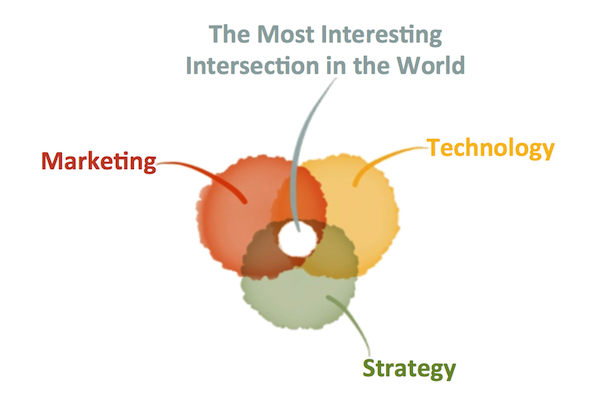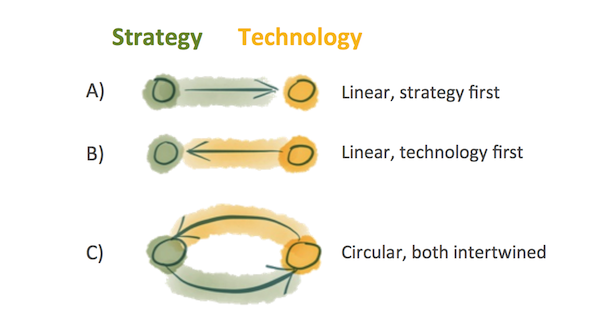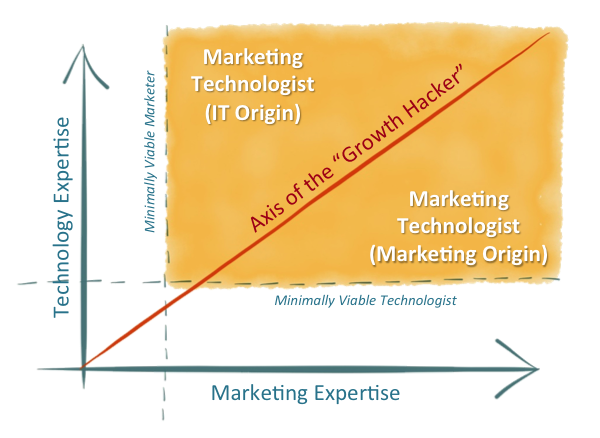

Strategy, marketing, and technology are all intertwined
source link: https://chiefmartec.com/2014/01/strategy-marketing-technology-intertwined/
Go to the source link to view the article. You can view the picture content, updated content and better typesetting reading experience. If the link is broken, please click the button below to view the snapshot at that time.

Strategy, marketing, and technology are all intertwined

Joe Pulizzi and Robert Rose covered my latest marketing technology landscape as part of their PNR: This Old Marketing podcast this week. They start on this segment around the 24:49 mark, with a riff on the Saturday Night Live The Rent Is Too Damn High skit. “Digital marketing is too damn complicated!”
It’s a terrific discussion about the interplay between marketing, technology, IT, strategy, and process. These were some of the points raised in their chat:
- “Technology is definitely outpacing our ability to consume it as marketers.”
- Buying technology is not a good way to figure out your strategy.
- Most marketers aren’t using the technology they already have very well.
- These problems happen when marketers are in charge of technology purchases.
- Marketing and IT need to be better aligned and more collaborative.
- You should determine your strategy and process first, and then find the right software to execute that — fit the tool to the problem, not the problem to the tool.
- The only thing technology can do is make your processes more efficient.
I agree enthusiastically with about 75% of that. But there are three points I’d make:
- Marketing technology is not just about efficiency — it’s about experiences.
- The relationship between strategy and technology is circular, not linear.
- Marketers cannot abdicate their responsibility to understand technology.
Strategy, marketing, and technology are all intertwined. To reference the How to Draw an Owl post from Seth Godin that Joe and Robert mention later in their podcast, the reality is more complex than just drawing two circles.
Marketing technology is about both efficiency and experiences
Here’s the one quote from the podcast that I really disagree with (emphasis partly mine):
“Figure out your process first. And then get aligned with your internal IT guys to figure out what it is you exactly need to facilitate. Because that’s the only thing that technology will ever, ever do. The only thing technology will ever do is facilitate a process that you have more efficiently. That’s all it’s ever going to do.”
Um, no. That trivializes the role of technology in modern marketing too much.
Marketing technology is not just about making existing processes more efficient. It’s the interface by which marketing sees and touches the digital world. Your choice of marketing software — and how you use it — will shape the experiences you deliver to prospects and customers.
Examples include: web and mobile marketing apps, webinar and virtual event software, personalization, gamification, interactive ads, and so on. In content marketing, Uberflip is a great example of marketing software that is more about experience than efficiency.
Other marketing technology is focused on efficiency, but not always by facilitating existing processes. In many cases, it’s about creating entirely new kinds of processes that weren’t even possible before.
For instance, using marketing automation to simply schedule batch-and-blast email is an example of making an existing process slightly more efficient. But the bigger opportunity is to create more personalized, behavior-driven nurturing processes that weren’t conceivable with manually operated email marketing. By the way, this doesn’t just make lead nurturing more efficient — it can make it a much better nurturing experience for your audience too.
I do agree with Joe and Robert that technology is not a magic bullet. It won’t absolve you of the need to produce brilliant content. But the interplay between technology and strategy is more complex than one merely being the handmaiden of the other.
The relationship between strategy and technology is circular
Joe and Robert make the excellent point that you shouldn’t buy a bunch of technology and then try to figure out what strategy you can create with it — Option B) in the sketch below. I wholeheartedly agree. No technology is a strategy-in-a-box.

However, simply inverting that approach into Option A) — define your strategy, and then go looking for technology to help implement it — isn’t quite right either.
Why? Because technological innovations change what kinds of strategies are possible. If you don’t let technology influence and inspire your strategy, you’re missing the opportunity to innovate your own business.
The right approach is Option C), more of a circular relationship. You want to understand what is technically possible — a frontier that is constantly advancing — to inform your strategy development. Your strategy then guides where you make greater technology investments. And what you learn from using that technology, especially as it evolves, should feedback into the refinement of your strategy. Managed well, this can be a virtuous cycle.
Keep in mind this Steve Jobs quote: “People don’t know what they want until you show it to them.” And Henry Ford, who said, “If I had asked people what they wanted, they would have said faster horses.” Innovation is often achieved through non-linear leaps.
Continuously experimenting with new, emerging technologies does not have to be the negative “shiny object syndrome.” If it’s done in moderation, as part of an intentional exploration of how your business can harness new innovations, it can be an evergreen source of competitive advantage.
Marketers must take responsibility for their technology
Joe and Robert attribute a quote to Scott Stratten of UnMarketing fame, “We suck at the technology we have, much less buying anything new.” (Although with a little bit of Googling, I haven’t been able to find that quote.)
I don’t disagree with the diagnosis. After all, this explosion of technology is a fairly new aspect of marketing, so it’s not surprising that we collectively have little professional intuition about how to harness and manage it. However, the answer is not to downplay technology. The answer is to get better at using it well.
The reason why the CMO will spend more on technology than the CIO is because it’s through software-mediated channels that we’re engaging our audience. Marketing is increasingly about designing and delivering customer experiences, and software is the digital clay we use to sculpt them. The CMO is responsible for that outcome, so it makes sense that the CMO should take a leadership role in the technology strategy to achieve it.
Of course, marketing and IT should work together. Marketing must adhere to IT governance as much as it does financial governance. Security, regulatory requirements, business continuity, integration with the rest of a company’s IT systems, etc., are all important facets of good technology management. Marketing cannot be a rogue state.
But if marketing doesn’t really understand technology — and IT doesn’t really understand marketing — then their “collaboration” can all too easily look like this: Marketing asks for faster horses. IT gives them faster horses. The automobile passes both of them by.
Other things being equal, IT will seek to minimize costs and risks in technology purchases. That’s a valuable perspective — but it’s not the only one that matters. Customer experience matters. Marketing performance matters. And the software that is the cheapest or easiest to buy may not be the most effective for marketing’s purpose. Standardizing on everything from GigantorSoft may optimize procurement — but that’s not as important as optimizing customer acquisition and delight.
Marketing must have a strong enough grasp of technology to advocate for the software to achieve its goals — and, more importantly, to be able to apply it effectively when they get it. But how do we get there from here, if marketing doesn’t have those capabilities today?
The best path I’ve seen is for marketing and IT to embrace a class of hybrid professionals called marketing technologists. These are people with expertise in both marketing and technology, and they fluidly intermingle the two disciplines.

They may come from a predominantly IT background or a marketing one, but they are credible on both dimensions. They may directly report into IT or marketing — I’ve seen both work, but the latter is more common — but they serve the mission of smartly applying technology in the pursuit of brilliantly effective marketing.
Whether you love or hate the term “growth hacker,” that’s an apt phrase for some of the best work that marketing technologists do.
Not everyone in marketing needs to be a marketing technologist. But having that capability within marketing’s team changes marketing’s relationship with technology. It’s no longer the way a Neanderthal might look at fire, “Oooh, pretty! Ouch! Ouch! Ouch!” It’s more like how a blacksmith harnesses fire to forge objects of great strength and beauty.
Recommend
About Joyk
Aggregate valuable and interesting links.
Joyk means Joy of geeK